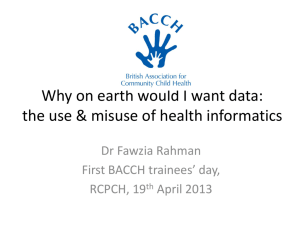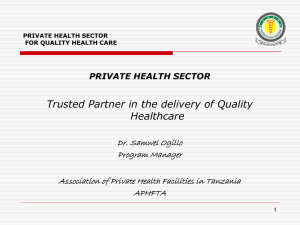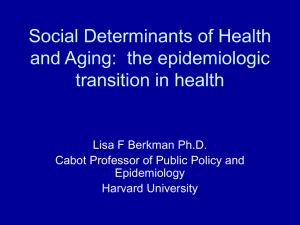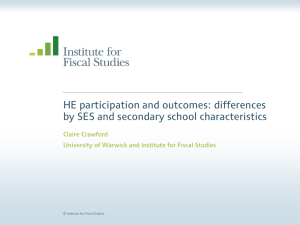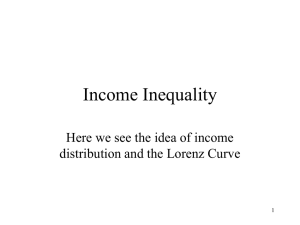Socio-economic gaps in HE participation: how have they changed over time?
advertisement
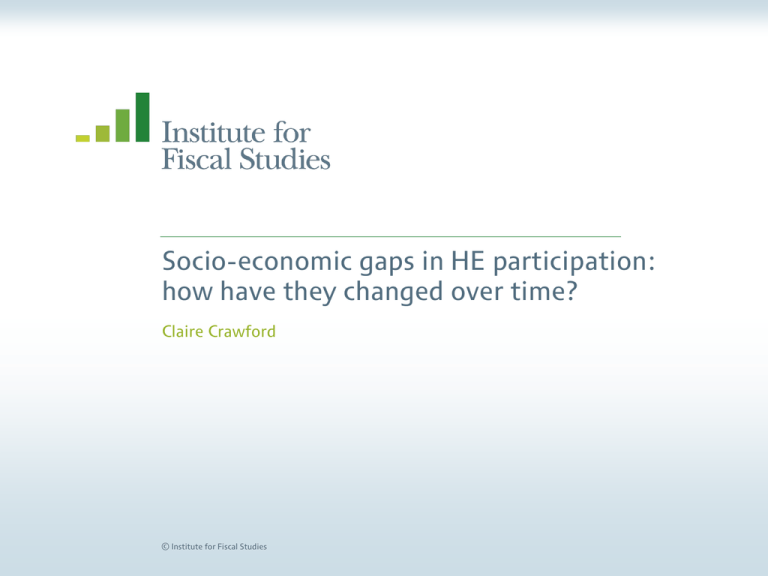
Socio-economic gaps in HE participation: how have they changed over time? Claire Crawford © Institute for Fiscal Studies Motivation: rising socio-economic inequalities in HE participation and degree acquisition over time Difference in HE participation/degree acquisition rates between those in the top and bottom income quintile groups Percentage point difference 45.0 40.0 35.0 30.0 22.6ppts 18.9ppts 25.0 20.0 15.0 10.0 5.0 0.0 NCDS BCS HE participation at age 19 BHPS Degree acquisition by age 23 Source: Blanden & Machin (2004), Educational inequality and the expansion of UK higher education, Scottish Journal of Political Economy, Special Issue on the Economics of Education, Vol. 51, pp. 230-249. © Institute for Fiscal Studies Change: NCDS to BHPS Motivation: what has happened since then? • Fees and student support arrangements have changed dramatically – 1998: upfront tuition fees of around £1,000 are introduced • No fee loans – 2006-07: deferred fees of up to £3,000 can now be charged • Though no longer payable upfront, and accompanied by a 0% real interest rate fee loan, repayable only above an income threshold and written off after a period of time – 2012-13: deferred fee cap raised to £9,000 • Still repaid after graduation (above a higher threshold), but with a positive real interest rate while studying and for the richest graduates, and written off after a longer period • SES differences in some measures of attainment have been falling © Institute for Fiscal Studies SES gap in terms of % getting 5 A*-C grades in GCSEs and equivalents has fallen substantially % pupils getting 5 A*-C grades in GCSEs and equivalents 90% 35% 80% 30% 70% 25% 60% 50% 20% 40% 15% 30% 10% 20% 5% 10% 0% 0% 2004 2005 2006 FSM 2007 Non-FSM 2008 2009 2010 Difference (RH axis) 2010-2011 figures based on SFR 03/2012: GCSE and Equivalent Attainment by Pupil Characteristics in England. 2006-2009 figures based on SFR 37/2010: GCSE and Equivalent Attainment by Pupil Characteristics in England. 2004-2005 figures based on authors’ calculations using Key Stage 4 and PLASC data. © Institute for Fiscal Studies 2011 Motivation: what does this mean for SES gaps in HE participation? • Concerns that the prospect of high fees/debt levels would create a barrier to participation for poorer students (e.g. Callendar, 2003) and hence increase SES gaps in HE participation – But previous IFS research (Dearden et al, 2007; Chowdry et al, 2012) suggests that the poorest graduates would be better off (i.e. have to pay back less) under the new fee regimes than their predecessors – Assuming students and their families understand the system (a big if!), the key issue is whether they are put off by the prospect of high debt • Given the key role of prior attainment in driving HE participation, the fact that poorer students are “catching up” with their better off peers may potentially reduce SES gaps in HE participation © Institute for Fiscal Studies Building on existing (UK) research • SES gaps in HE participation and how they’ve changed over time – e.g. Blanden & Machin (2004); Corver (2010) • Papers that seek to identify the effects of HE finance reforms – e.g. Dearden, Fitzsimons & Wyness (2011) • Our contribution is to: – Show what happened to SES gaps in HE participation (including at high status unis) over the 2000s using individual-level admin data – Use a combined individual and area level measure of SES – Show whether/how the trend in participation rates changed after 2006-07 (but we will NOT identify the causal effect of the reforms) – Consider whether changes in background characteristics (including prior attainment) can help to explain the changing SES gaps © Institute for Fiscal Studies Key research questions • What happened to HE participation (including at high status institutions) among state school students in England between 2004-05 and 2010-11? • Did the trends in HE participation change following the increase in tuition fees (and other changes to student support) in 2006-07? • How do these patterns vary by socio-economic status? • To what extent can background characteristics explain differences in HE participation over time and between socio-economic groups? © Institute for Fiscal Studies Data • National Pupil Database (NPD) – Census of pupils in Year 11 in England: 2001-02 to 2006-07 – Key Stage test results at ages 11, 16 and 18 – Limited background characteristics for those in state schools • e.g. gender, ethnicity, FSM eligibility, home postcode • Higher Education Statistics Agency (HESA) data – Census of students attending UK universities: 2004-05 to 2010-11 • Linked NPD-HESA data: – Provides us with the population of state school students taking (or eligible to take) GCSEs in England between 2001-02 and 2006-07 – Enables us to follow individuals from the end of primary school through to potential HE participation at age 18 or 19 © Institute for Fiscal Studies Outcomes • Participation at any UK HE institution at age 18 or 19 • Participation at a “high status” institution, where high status is: – Russell Group institutions (20 in total pre-2012) – Plus any UK university with a 2001 average RAE score higher than the lowest amongst the Russell Group (an extra 21 institutions) – 9.8% of state school pupils attend such institutions (31% of HE participants from state schools) • Amongst the cohort first eligible to go to university in 2009-10: – 34.4% of state school pupils participated at age 18 or 19 – 9.9% attended a high status institution (28.8% of participants) © Institute for Fiscal Studies Measure of socio-economic status • Combine FSM eligibility at age 16 with measures of local area deprivation based on pupils’ home postcode at age 16 using PCA – Index of Multiple Deprivation score (SOA level; approx. 700 HHs) – ACORN group (postcode level; approx. 15 HHs) – % of population from 2001 census (OA level; approx. 150 HHs): • Who work in higher or lower managerial/professional occupations • Whose highest educational qualification is NQF Level 3 or above • Who own (either outright or through a mortgage) their home • Split state school population into quintile groups based on this index © Institute for Fiscal Studies HE participation at age 18 or 19 (state school pupils) 60% 50% 40.0ppts 40% 39.3ppts 37.7ppts 37.5ppts 37.5ppts 37.3ppts 2006–07 2007–08 2008–09 2009–10 30% 20% 10% 0% 2004–05 © Institute for Fiscal Studies 2005–06 Difference (least–most) Most deprived quintile 2nd quintile Middle quintile 4th quintile Least deprived quintile HE participation at a high status institution at age 18 or 19 (amongst state school pupils) 25% 20% 19.7ppts 19.0ppts 19.4ppts 19.7ppts 19.5ppts 19.0ppts 2005–06 2006–07 2007–08 2008–09 2009–10 15% 10% 5% 0% 2004–05 © Institute for Fiscal Studies Difference (least–most) Most deprived quintile 2nd quintile Middle quintile 4th quintile Least deprived quintile Modelling HE participation (1) • Were the changes to HE finance introduced in 2006-07 associated with changes in (the socio-economic gradient in) HE participation? • Try to model what would have happened to HE participation (in the absence of supply constraints) had there been no policy changes • Include in our model: – The four highest quintile groups on the basis of our SES index – A linear time trend – An indicator for first being eligible to go to HE in or after 2006-07 – Interactions between SES quintile group and our post 2006-07 indicator • Aim is to understand whether participation in and after 2006-07 was higher or lower than might have been expected on the basis of prior trends and whether this differs by socio-economic background – NOT a causal analysis © Institute for Fiscal Studies HE participation at age 18 or 19 amongst state school pupils before and after 2006-07 60.0% 50.0% 40.0% 30.0% 20.0% 10.0% 0.0% -10.0% Most deprived quintile group Before 2006-07 © Institute for Fiscal Studies 2nd quintile group Middle quintile group 4th quintile group Least deprived quintile group 2006-07 onwards: difference compared to before 2006-07 High status participation at age 18 or 19 amongst state school pupils before and after 2006-07 25.0% 20.0% 15.0% 10.0% 5.0% 0.0% Most deprived quintile group Before 2006-07 © Institute for Fiscal Studies 2nd quintile group Middle quintile 4th quintile group Least deprived group quintile group 2006-07 onwards: difference compared to before 2006-07 Modelling HE participation (2) • Investigate the extent to which differences in HE participation by SES and over time can be explained by differences in the composition of state school pupils, by successively adding: – Individual characteristics (gender, ethnicity, special educational needs, month of birth, English as a second language) and school fixed effects – Key Stage 2 attainment (age 11) – Key Stage 4 attainment (age 16) – Key Stage 5 attainment (age 18) © Institute for Fiscal Studies Differences in HE participation between most and least deprived quintile groups before and after 2006-07 45.0 Percentage point difference 40.0 35.0 30.0 25.0 20.0 15.0 10.0 5.0 0.0 Raw Plus individual characteristics and school fixed effects Plus Key Stage 2 results Before 2006–07 © Institute for Fiscal Studies Plus Key Stage 4 results 2006–07 onwards Plus Key Stage 5 results Differences in high status participation between most and least deprived quintile groups before and after 2006-07 Percentage point difference 25.0 20.0 15.0 10.0 5.0 0.0 Raw Plus individual characteristics and school fixed effects Plus Key Stage 2 results Before 2006–07 © Institute for Fiscal Studies Plus Key Stage 4 results 2006–07 onwards Plus Key Stage 5 results Summary and conclusions (1) • HE participation amongst state school pupils at age 18 or 19 rose by almost 5 percentage points between 2004-05 and 2010-11 – But there was little change in participation at high status institutions • Participation increased more quickly for pupils from deprived backgrounds, such that the gap in HE participation – and to a lesser extent high status participation – fell over this period – Gap in participation between state school students from the most and least deprived quintile groups fell from 40 ppts to 37 ppts • Improved relative performance of deprived pupils in earlier achievement tests partly explains decrease in participation gap © Institute for Fiscal Studies Summary and conclusions (2) • Evidence of a small but temporary dip in participation in 2006-07 – Largest amongst state school pupils from better-off families • Upward trend in HE participation continued after 2006-07 – More quickly for those from the poorest backgrounds • Cannot say for sure that this change arose as a consequence of the new HE finance regime introduced in 2006-07, but: – Was coincident with it and cannot be explained using other characteristics observed in our data – Is a plausible response to the reforms, which were more generous to students from poor families and hit richer students relatively harder © Institute for Fiscal Studies

